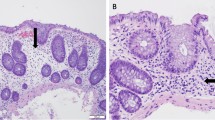Abstract
Purpose
To determine the frequency, imaging, and clinical manifestations of immune checkpoint inhibitor (ICI)-related colitis in cancer patients on monotherapy or combination therapy.
Methods
The electronic medical records of 1044 cancer patients who received ICIs were retrospectively reviewed to identify 48 patients who had a clinical diagnosis of immune-related colitis. Imaging studies were reviewed to identify patients with imaging manifestations of colitis. Demographic data, type of ICIs, symptoms, presence of other immune-related adverse events (irAEs), and management were recorded.
Results
There was imaging evidence of immune-related colitis in 34 patients (24 men; median age: 63.5 years). The median time to onset of colitis was 75 days (IQR 25–75, 49.5–216 days) in patients receiving monotherapy (group 1) and 78 days (IQR 25–75, 44.3–99.5 days) in patients undergoing combination therapy (group 2) following start of ICI. Symptoms included diarrhea (91.1% [31 of 34]), nausea/vomiting (52.9% [18 of 34]), and abdominal pain (52.9% [18 of 34]). The most common imaging findings were bowel wall thickening (97% [33 of 34]) and fluid-filled colon (82.3% [28 of 34]). Colitis was diffuse in 21 of 34 (61.8%) patients. Imaging manifestations did not differ between the two groups (p > 0.05). Steroids and antibiotics were used to treat colitis in 29 of 34 (85.2%) and 13 of 34 (38.2%) patients, respectively. No patients in group 1 experienced concurrent irAEs, but 5 of 18 (27.8%) of patients in group 2 had other irAEs (p = 0.046).
Conclusion
Immune-related colitis occurred in 3.3% of patients receiving ICIs with bowel wall thickening, fluid-filled colon and pancolitis being the most common imaging manifestations. Imaging manifestations did not differ between patients receiving monotherapy or combination therapy. However, concurrent irAEs were significantly observed in patients undergoing combination therapy.



Similar content being viewed by others
References
Press Announcements > FDA approves new treatment for a type of late-stage skin cancer. https://web.archive.org/web/20110327063147/http://www.fda.gov/NewsEvents/Newsroom/PressAnnouncements/ucm1193237.htm. Published March 27, 2011. Accessed June 2, 2019.
Wolchok JD, Chiarion-Sileni V, Gonzalez R, et al (2017) Overall Survival with Combined Nivolumab and Ipilimumab in Advanced Melanoma. N Engl J Med 377:1345-1356.
Tirumani SH, Ramaiya NH, Keraliya A, Bailey ND, Ott PA, Hodi FS, Nishino M (2015) Radiographic Profiling of Immune-related Adverse Events in Advanced Melanoma Patients Treated With Ipilimumab. Cancer Immunol Res 3:1185-1192.
Puzanov I, Diab A, Abdallah K, et al (2017) Managing toxicities associated with immune checkpoint inhibitors: consensus recommendations from the Society for Immunotherapy of Cancer (SITC) Toxicity Management Working Group. J Immunother Cancer 5:95.
Kim KW, Ramaiya NH, Krajewski KM, Shinagare AB, Howard SA, Jagannathan JP, Ibrahim N (2013) Ipilimumab-associated colitis: CT findings. AJR Am J Roentgenol 200:W468-474.
Mekki A, Dercle L, Lichtenstein P, et al (2018) Detection of immune-related adverse events by medical imaging in patients treated with anti-programmed cell death 1. Eur J Cancer 96:91-104.
Beck KE, Blansfield JA, Tran KQ, et al (2006) Enterocolitis in patients with cancer after antibody blockade of cytotoxic T-lymphocyte-associated antigen 4. J Clin Oncol 24:2283-2289.
Weber J, Thompson JA, Hamid O, et al (2009) A randomized, double-blind, placebo-controlled, phase II study comparing the tolerability and efficacy of ipilimumab administered with or without prophylactic budesonide in patients with unresectable stage III or IV melanoma. Clin Cancer Res 15:5591-5598.
Haanen JBAG, Carbonnel F, Robert C, Kerr KM, Peters S, Larkin J, Jordan K; ESMO Guidelines Committee (2017) Management of toxicities from immunotherapy: ESMO Clinical Practice Guidelines for diagnosis, treatment and follow up. Ann Oncol 28(suppl 4):iv119-iv142.
Sosa A, Cadena EL, Olive CS, Karachaliou N, Rosell R (2018) Clinical assessment of immune-related adverse events. Ther Adv Med Oncol 10:1758835918764628.
Friedman CF, Proverbs-Singh TA, Postow MA (2016) Treatment of the Immune-Related Adverse Effects of Immune Checkpoint Inhibitors: A Review. JAMA Oncol 2:1346-1353.
Gupta A, De Felice KM, Loftus EV Jr, Khanna S (2015) Systematic review: colitis associated with anti-CTLA-4 therapy. Aliment Pharmacol Ther 42:406-417.
Garcia-Neuer M, Marmarelis ME, Jangi SR, et al (2017) Diagnostic Comparison of CT Scans and Colonoscopy for Immune-Related Colitis in Ipilimumab-Treated Advanced Melanoma Patients. Cancer Immunol Res 5:286-291.
Wang DY, Ye F, Zhao S, Johnson DB (2017) Incidence of immune checkpoint inhibitor-related colitis in solid tumor patients: A systematic review and meta-analysis. Oncoimmunology 6:e1344805.
Horn L, Spigel DR, Vokes EE, et al (2017) Nivolumab Versus Docetaxel in Previously Treated Patients With Advanced Non-Small- Cell Lung Cancer: Two-Year Outcomes From Two Randomized, Open-Label, Phase III Trials (CheckMate 017 and CheckMate 057). J Clin Oncol 35:3924-3933.
Alessandrino F, Sahu S, Nishino M, et al (2019) Frequency and imaging features of abdominal immune-related adverse events in metastatic lung cancer patients treated with PD-1 inhibitor. Abdom Radiol (NY) 44:1917-1927.
Larkin J, Hodi FS, Wolchok JD (2015) Combined nivolumab and ipilimumab or monotherapy in untreated melanoma. N. Engl. J. Med 373:1270-1271.
Irwin DE, Davis B, Bell JA, Galaznik A, Garcia-Ribas I (2018) Gastrointestinal complications in patients treated with ipilimumab and nivolumab combination therapy or monotherapy. J Comp Eff Res 8:81-90.
Reddy HG, Schneider BJ, Tai AW (2018) Immune Checkpoint Inhibitor-Associated Colitis and Hepatitis. Clin Transl Gastroenterol 9:180.
Zhou S, Khanal S, Zhang H (2019) Risk of immune-related adverse events associated with ipilimumab-plus-nivolumab and nivolumab therapy in cancer patients. Ther Clin Risk Manag 15:211-221.
Author information
Authors and Affiliations
Corresponding author
Ethics declarations
Conflict of interest
The authors declare that there is no conflict of interest regarding the publication of this article.
Additional information
Publisher's Note
Springer Nature remains neutral with regard to jurisdictional claims in published maps and institutional affiliations.
Rights and permissions
About this article
Cite this article
Shieh, A.C., Guler, E., Pfau, D. et al. Imaging and clinical manifestations of immune checkpoint inhibitor-related colitis in cancer patients treated with monotherapy or combination therapy. Abdom Radiol 45, 3028–3035 (2020). https://doi.org/10.1007/s00261-019-02334-3
Published:
Issue Date:
DOI: https://doi.org/10.1007/s00261-019-02334-3




